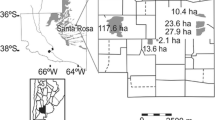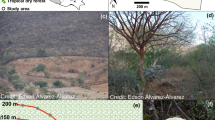Abstract
Habitat fragmentation alters many ecological processes, including trophic cascades. For example, increased predation pressure along habitat edges has often been observed in fragmented landscapes. Here, we studied how nest predation risk varies along the transition zone between grassland and mixed forest in Central Europe. Using artificial nests, we tested the two mechanisms that are expected to underlie higher predation rates along edges: (1) the matrix effect model that supposes predator penetration from a habitat type with higher predator density to one with lower predator density and (2) the ecotonal effect model that assumes specific predator preferences for habitat edges. Although our results do not fully support either of these scenarios, our data show high temporal instability in nest predation along forest–grassland edges. Predation was higher in habitat interiors compared to edges during the first year, whereas the opposite pattern was observed during the subsequent year. In addition, dramatic between-year differences in the species composition of nest predators were observed. Therefore, we hypothesise that the effect of edges on nest predation is difficult to predict in landscapes with high predator diversity. In addition, our data indicate that a high abundance of wild boar considerably increases the risk of predation for ground-nesting birds.


Similar content being viewed by others
References
Albrecht T (2004) Edge effect in wetland-arable land boundary determines nesting success of Scarlet Rosefinch (Carpodacus erythrinus) in the Czech Republic. Auk 121:361–371
Anděra M, Horáček I (2005) Poznáváme naše savce. Sobotáles, Praha [In Czech].
Andrén H (1992) Corvid density and nest predation in relation to forest fragmentation: a landscape perspective. Ecology 73:794–804
Andrén H (1995) Effects of landscape composition on predation rates at habitat edges. In: Hansson L, Fahrig L, Merriam G (eds) Mosaic landscapes and ecological processes, Chapmann and Hall, London, pp 225–255
Andrén H, Angelstam P (1988) Elevated predation rates as an edge effect in habitat islands: experimental evidence. Ecology 69:544–547
Angelstam P (1986) Predation on ground-nesting birds’ nests in relation to predator densities and habitat edge. Oikos 47:365–373
Báldi A, Batáry P (2000) Do predation rates of artificial nests differ between edge and interior reedbed habitats? Acta Ornitol 35:53–56
Batáry P, Báldi A (2004) Evidence for edge effect on avian nest success. Conserv Biol 18:389–400
Batáry P, Winkler H, Báldi A (2004) Experiments with artificial nests on predation in reed habitats. J Ornithol 145:59–63
Bayne EM, Hobson KA (1997) Comparing the effects of landscape fragmentation by forestry and agriculture on predation of artificial nests. Conserv Biol 11:1418–1429
Bayne EM, Hobson KA (1999) Do clay eggs attract predators to artificial nests? J Field Ornithol 70:1–7
Bêty J, Gauthier G, Giroux JF, Korpimaki E (2001) Are goose nesting success and lemming cycles linked? Interplay between nest density and predators. Oikos 93:388–400
Bieber C, Ruf T (2005) Population dynamics in wild boar Sus scrofa: ecology, elasticity of growth rate and implications for the management of pulsed resource consumers. J Appl Ecol 42:1203–1213
BirdLife International (2004) Birds in Europe: population estimates, trends and conservation status. BirdLife International (BirdLife conservation series no. 12), Cambridge
Burnham KP, Anderson DR (2002) Model selection and multimodel inference: a practical information-theoretic approach, 2nd ed. Springer, New York
Castilla AM, Dhondt AA, Uriarte RD, Westmoreland D (2007) Predation in ground-nesting birds: an experimental study using natural egg-color variation. Avian Conservation and Ecology - Écologie et conservation des oiseaux 2(1):2. Available at http://www.ace-eco.org/vol2/iss1/art2
Chalfoun AD, Thompson FR, Ratnaswamy MJ (2002a) Nest predators and fragmentation: a review and meta-analysis. Conserv Biol 16:306–318
Chalfoun AD, Ratnaswamy MJ, Thompson FR (2002b) Songbird nest predators in forest-pasture edge and forest interior in fragmented landscape. Ecol Appl 12:858–867
Crawley MJ (2002) Statistical computing. Wiley, Chichester
Crooks KR (2002) Relative sensitivities of mammalian carnivores to habitat fragmentation. Conserv Biol 16:488–502
Crooks KR, Soulé ME (1999) Mesopredator release and avifaunal extinctions in fragmented systems. Nature 400:563–566
Dijak WD, Thompson FR (2000) Landscape and edge effects on the distribution of mammalian predators in Missouri. J Wildlife Manage 64:209–216
Donovan TM, Jones PW, Annand EM, Thompson FR (1997) Variation in local-scale edge effects: mechanism and landscape context. Ecology 78:2064–2075
Flaspohler DJ, Temple SA, Rosenfield RN (2001) Species-specific edge effects on nest success and breeding density in a forested landscape. Ecol Appl 11:32–46
Gates JE, Gysel LW (1978) Avian nest dispersion and fledging success in field-forest ecotones. Ecology 59:871–883
Gehring TM, Swihart RK (2003) Body size, niche breadth, and ecologically scaled responses to habitat fragmentation: mammalian predators in an agricultural landscape. Biol Conserv 109:283–295
Geisser H, Reyer HU (2005) The influence of food and temperature on population density of wild boar Sus scrofa in the Thurgau (Switzerland). J Zool 267:89–96
Götmark F (1992) Blue eggs do not reduce nest predation in the song thrush, Turdus philomelos. Behav Ecol Sociobiol 30:245–252
Haskell DG (1995) Forest fragmentation and nest predation: are experiments with Japanese quail eggs misleading? Auk 112:767–770
Heske EJ (1995) Mammalian abundances on forest-farm edges versus forest interiors in southern Illinois: is there an edge effect? J Mammal 76:562–568
Hilty JA, Merenlender AM (2004) Use of riparian corridors and vineyards by mammalian predators in Northern California. Conserv Biol 18:26–135
Hone J (2002) Feral pigs in Namadgi National Park, Australia: dynamics, impacts and management. Biol Conserv 105:231–242
Hudec K, Šťastný K (2005) Fauna ČR. Ptáci 2/2. Academia Praha. [In Czech]
Huhta E, Jokimäki J, Helle P (1998) Predation on artificial nests in a forest dominated landscape—the effect on nest type, patch size and edge structure. Ecography 21:464–471
Jobin B, Picman J (1997) The effect of egg coloration on predation of artificial ground nests. Can Field Nat 111:591–594
Koubová M, Suvorov P, Svobodová J, Albrecht T, Kreisinger J (2011) Predation in landscapes affected by fragmentation and loss of natural habitats. In: Daniels JA (ed) Advances in environmental research, 14th ed. Nova Science Publishers, New York
Kreisinger J, Albrecht T (2008) Nest protection in mallards Anas platyrhynchos: untangling the role of crypsis and parental behaviour. Funct Ecol 22:872–879
Lahti DC (2001) The “edge effect on nest predation” hypothesis after twenty years. Biol Conserv 99:365–374
Lecomte N, Careau V, Gauthier G, Giroux JF (2008) Predator behaviour and predation risk in the heterogeneous Arctic environment. J Animal Ecol 77:439–447
Lidicker WZ Jr (1999) Responses of mammals to habitat edges: an overview. Landscape Ecol 14:333–343
Maestas JD, Knight RL, Gilgert WC (2003) Biodiversity across a rural land-use gradient. Conserv Biol 17:1425–1434
Maier TJ, DeGraaf RM (2000) Differences in depredation by small predators limit the use of plasticine and zebra finch eggs in artificial-nest studies. Condor 103:180–183
Malt J, Lank D (2007) Temporal dynamics of edge effects on nest predation risk for the marbled murrelet. Biol Conserv 140:160–173
Mazgajski TD, Rejt Ł (2005) Forest fragmentation size affects edge effect in nest predation—experiment with artificial nests. Pol J Ecol 53:233–242
Nour N, Erik M, Dhondt AA (1993) Artificial nest predation and habitat fragmentation: different trends in birds and mammal predators. Ecography 16:111–116
Padyšáková E, Šálek M, Poledník L, Sedláček F, Albrecht T (2010) Predation on simulated duck nests in relation to nest density and landscape structure. Wildl Res 37:597–603
Pasitschniak-Arts M, Messier F (1995) Risk of predation on waterfowl nests in the Canadian prairies: effects of habitat edges and agricultural practices. Oikos 73:347–355
Paton PWC (1994) The effect of edge on avian nesting success—how strong is the evidence? Conserv Biol 8:17–26
R Development Core Team (2008) R: a language and environment for statistical computing. Vienna, Austria. Available at http://www.Rproject.org
Reif J, Voříšek P, Šťastný K, Bejček V, Petr J (2008) Agricultural intensification and farmland birds: new insights from a central European country. Ibis 150:596–605
Ries L, Sisk TD (2004) A predictive model of edge effects. Ecology 85:2917–2926
Ries L, Fletcher RJ Jr, Battin J, Sisk TD (2004) Ecological responses to ecological edges: mechanism, models, and variability explained. Annu Rev Ecol Evol Systemat 35:491–522
Robinson SK, Thompson FR, Donovan TM, Whitehead DR, Faaborg J (1995) Regional forest fragmentation and the nesting success of migratory birds. Science 267:1987–1990
Saez-Royuela C, Telleria JL (1986) The increased population of the wild boar (Sus scrofa, L.) in Europe. Mammal Rev 16:97–101
Šálek M, Kreisinger J, Sedláček F, Albrecht T (2009) Corridor versus hayfield matrix use by mammalian predators in an agricultural landscape. Agr Ecosyst Environ 134:8–13
Šálek M, Kreisinger J, Sedláček F, Albrecht T (2010) Do prey densities determine preferences of mammalian predators for habitat edges in an agricultural landscape? Landscape Urban Plan 98:86–91
Schmidt KA (2003) Nest predation and population declines in Illinois songbirds: a case for mesopredator effects. Conserv Biol 17:1141–1150
Söderström B, Pärt T, Ryden J (1998) Different predator faunas and nest predation risk on ground and shrub nests at forest ecotones: an experiment and a review. Oecologia 117:108–118
Spanhove T, Lehouck V, Boets P, Lens L (2009) Forest fragmentation relaxes nest predation in an Afromonate forest. Animal Conserv 12:267–275
Stephens SE, Koons DN, Rotella JJ, Willey DW (2003) Effects of habitat fragmentation on avian nesting success: a review of the evidence at multiple spatial scales. Biol Conserv 115:101–110
Storch I (1991) Habitat fragmentation, nest site selection, and nest predation risk in Capercaillie. Ornis Scandinavica 22:213–217
Storch I, Woitke E, Krieger S (2005) Landscape-scale edge effect in predation risk in forest-farmland mosaics of central Europe. Landscape Ecol 20:927–940
Svobodová J, Albrecht T, Šálek M (2004) The relationship between predation risk and occurrence of Black Grouse (Tetrao tetrix) in a highly fragmented landscape: an experiment based on artificial nests. Ecoscience 11:421–427
Svobodová J, Kreisinger J, Šálek M, Koubová M, Albrecht T (2011) Testing mechanistic explanations for mammalian predator responses to habitat edges. Eur J Wildl Res 57:467–474
Thompson FR, Burhans DE (2004) Differences in predators of artificial and real songbird nests: evidence of bias in artificial nest studies. Conserv Biol 18:373–380
Trnka A, Batáry P, Prokop P (2009) Interacting effects of vegetation structure and breeding patterns on the survival of Great Reed Warbler Acrocephalus arundinaceus nests. Ardea 97:109–116
Voříšek P, Jiguet F, van Strien A, Škorpilová J, Klvaňová A, Gregry RD (2010) European trends in farmland birds. BOU proceedings—lowland farmland birds. III.http://www.bou.org.uk/bouproc-net/lfb3/vorisek-etal.pdf.
Weidinger K (2001) Does egg colour affect predation rate on open passerine nests? Behav Ecol Sociobiol 49:456–464
Weidinger K (2002) Interactive effects of concealment, parental behaviour and predators on the survival of open passerine nests. J Animal Ecol 71:424–437
Weidinger K (2009) Nest predators of woodland open-nesting songbirds in central Europe. Ibis 151:352–360
Wilcove DS (1985) Nest predation in forest tracts and the decline of migratory songbirds. Ecology 66:1211–1214
Willebrand T, Marcström V (1988) On the danger of using dummy nests to study predation. Auk 105:378–379
Wilson DJ, Bromley RG (2001) Functional and numerical responses of predators to cyclic lemming abundance: effects on loss of goose nests. Can J Zool 79:525–532
Zanette L (2000) What do artificial nests tells us about nest predation? Biol Conserv 103:323–329
Zub K, Sönnichsen L, Szafrańska PA (2008) Habitat requirements of weasels Mustela nivalis constrain their impact on prey populations in complex ecosystems of the temperate zone. Oecologia 157:571–582
Acknowledgements
We thank Častoral O., Dýnková E., Kukač P. and Soustružník L. for their help with field work. Helpful comments to the manuscript were given by Batáry P. and Spanhove T. (reviewers of the manuscript), Gortázar Ch. (Editor-in-Chief of EJWR) and Šálek M.E. This study was supported by the internal grant agencies of the Czech University of Environmental Sciences (CIGA 20094205 and IGA FŽP 42110/1313/3108). T.A. and J.K. were partially supported by the Research Centrum project no. LC06073 and by the grant of the Ministry of Environment VAV no. SP/2d3/60/08.
Author information
Authors and Affiliations
Corresponding author
Additional information
Communicated by C. Gortázar
Rights and permissions
About this article
Cite this article
Svobodová, J., Koubová, M., Mrštný, L. et al. Temporal variation in nest predation risk along habitat edges between grassland and secondary forest in Central Europe. Eur J Wildl Res 58, 315–323 (2012). https://doi.org/10.1007/s10344-011-0582-2
Received:
Revised:
Accepted:
Published:
Issue Date:
DOI: https://doi.org/10.1007/s10344-011-0582-2




